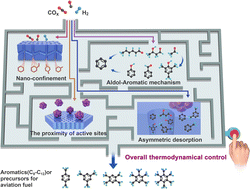COx conversion to aromatics: a mini-review of nanoscale performance
Abstract
The conversion of COx into value-added green aromatics is considered as a promising route to achieve the world's decarbonization due to its considerable thermodynamic driving force and atomic economy where low H/C ratio aromatics are chosen as a product. It is enabled by bifunctional nano-catalysts composed of metal oxides with abundant oxygen vacancies and acid zeolites, thus realizing superior selectivity in hydrocarbons at the single pass of COx conversion. In this mini-review, we mainly provide some thought-provoking insights at the nanoscale of this complicated process including the proximity of active sites, reaction mechanism, asymmetric desorption behavior of intermediates and final products and overall thermodynamic analysis. The facile surface diffusion of intermediates owing to the proximity of active sites stimulates the reaction, which follows an autocatalytic process. This positive feedback attributed to the autocatalytic cycle accelerates the transformation of energy and materials in the thermodynamically optimal direction, making the reaction highly selective towards the final products. This complicated coupling process, like a nano-maze constituted by these micro-environment factors, is complicated in terms of the reaction pathway but highly selective to a fixed direction guided by overall thermodynamics. Deep understanding of such an autocatalytic cycle at the nanoscale paves the way for the rational design of next-generation high-performance catalysts.

- This article is part of the themed collection: Nanoscale Horizons, Nanoscale, and ChemComm: Nanocatalysis


 Please wait while we load your content...
Please wait while we load your content...